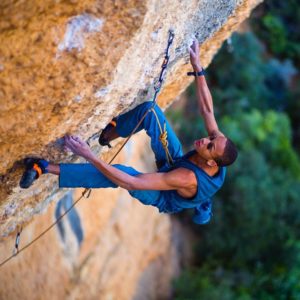Kai Lightner’s Youtube videos would have any viewer gasping and sitting on the edge of their seat while awaiting his next move. His tall, thin frame allows him to eloquently move along most vertical surfaces. But instead of perfecting his grip around a ball, he’s gripping a huge rock.
At 16-years-old, Lightner is already a rock-climbing champion and one of few Black professional rock climbers.
“Ever since I was a little kid I really liked climbing.” Lightner stated in the short film 14.c. “I used to climb everything, from flagpoles before I could walk… I [even] used to climb baby crates.”
According to Lightner’s coach Shane Messer, Lightner’s mother found him at the top of the basketball goal at their home and brought him into the gym at the age of six.
“He was going to climb regardless, it was love at first sight.” Lightner’s mother Connie Lightner mentioned in the short film 14.c. “He was hooked the first time he ever walked into a gym.”
Lightner’s resume is full of championship wins, including winning first place in a Youth National Championship at the age of 10. Some would say that Lightner is an anomaly being one of only a few Black professional rock climbers. In fact, the 2014 Outdoor Participation Report Foundation reported that only 11 percent of African-Americans participate in outdoor activities, while 70 percent of Caucasians enjoy outdoor activities.
These statistics, along with a long history of African-Americans not having the desire to partake in activities outdoors, have some experts conducting extensive research on the topic. Geographer Carolyn Finney, assistant professor of environmental science, policy, and management at the University of California at Berkeley and author of Black Faces, White Spaces: Reimagining the Relationship of African Americans to the Great Outdoors, finds that the connection is rich, but also distinct and fraught. Finney writes in her book that, “Those barriers would come to shape our most basic perceptions about who cherishes nature and who belongs in it.”
Unfortunately, fear for their safety has played a major role in the lack of diversity in outdoor activities.
Autumn Saxton-Ross leads Outdoor Afro, an organization that inspires African-Americans to get involved in outdoor events around Washington, D.C. Saxton-Ross told NPR that her grandmother used to take her to Watermelon Hill in Kansas City’s Swope Park, and until desegregation, it was the only place in the park that Black people were allowed to visit. With that history in mind, her grandmother wouldn’t take her to other parts of the park, even in the 1980s, long after segregation had ended, for fear that something bad might happen.
For others, “roughing it” in the outdoors might not seem enjoyable based on the dark history that has come with it. In his article for the Talking Points Memo, Brandon Harris, assistant professor of film at SUNY Purchase College, explains why many Black people don’t venture outdoors, after watching the film, Wild.
Harris writes, “For many blacks in the antebellum south, camping skills were essential. The faintest hope of freedom depended on surviving in the forests of the deep, still-wild south upon escaping from bondage.” He continues, “Many runaway slaves without the skills for survival in the forests of the south returned to their plantations when hunger and thirst grew too much to bear. Other escapees, fearing the possibility of re-enslavement, especially after the passage of the Fugitive Slave Act in 1850, continued to live deep in the swamps and forests of the region, in places they rightfully suspected whites would never go.”
He sites a passage from the book, A Tour of the United States of America, by Irish Author John Ferdinand Smyth in 1784:
Run-away Negroes have resided in these places for twelve, twenty, or thirty years and upwards, subsisting themselves in the swamp upon corn, hogs and fowls, that they raised on some of the spots not perpetually under water, nor subject to be flooded, as forty-nine parts of fifty of it are; and on such spots they have erected habitations, and cleared small fields around them; yet these have always been perfectly impenetrable to any of the inhabitants of the country around, even to those nearest to and best acquainted with the swamps.
“If you go back prior to the Civil War, African-Americans were sent outside to work in a form of forced labor,” said James Edward Mills, a journalist specializing in outdoor recreation and environmental conservation, in the Standard Examiner. “So you have this negative connotation of the outdoors as a place of physical hardship. Several decades later, and during the Civil Rights era, the woods were a place where African-Americans were taken to be hanged from trees.”
Mills’ book, The Adventure Gap: Changing the Face of the Outdoors, encourages minority communities to look outdoors for experiences that will enrich their lives.
Although African-Americans represent a low number of people that venture outdoors, there are organizations such as Black Ski Weekend and Urban Camp Weekend that aim to increase that percentage greatly.
Being in the minority doesn’t bother Lightner, as he continues to succeed in the sport that he loves. In his latest Youtube video, Lightner is seen tackling and finally conquering his hardest route— Era Vella in Spain. He was also recently added to the Adidas Outdoor Team.
“You should always have that ambition that drive to do the things you love to do,” Lightner said.



